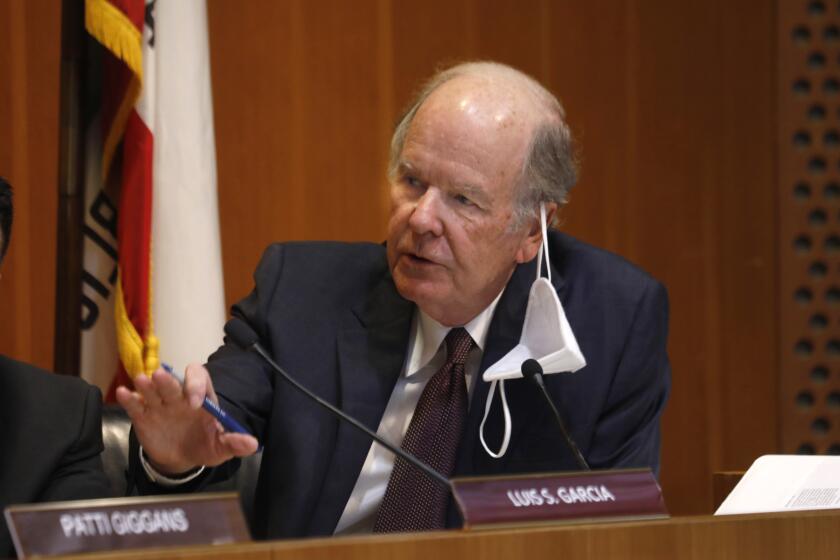Building Curbs Continued for Malibu Hills
- Share via
In a series of decisions that cheered environmental groups and angered county officials, the California Coastal Commission has decided to continue a controversial program designed to prevent overbuilding on Malibu’s rugged hillsides until the county comes up with rules to regulate the area’s growth.
The commission’s action also signaled the county that its rules should include some kind of guarantees that construction will be limited on thousands of small lots, which were created in the 1920s for cabins and tents, in the Santa Monica Mountains,
New construction in Malibu was limited to 6,582 units in a land-use plan agreed upon by the coastal panel and the county in December after years of difficult negotiation. Only 1,200 of those will be allowed in rural areas.
And no more than 2,110 units may be built until Pacific Coast Highway is improved.
But the building caps alone will not be enough to adequately control growth in Malibu, coastal commissioners said at a meeting in Marina del Rey last week.
New subdivisions, as well as condominiums and apartments, in coastal Malibu must be offset by preserving open space in the nearby mountains, the panel decided.
The panel’s votes on four test cases constitute “the most significant decision the commission has made on the future of the Santa Monica Mountains, even in many respects more significant than the land-use plan itself,” said Peter M. Douglas, the commission’s executive director.
‘Handwriting Is Clear’
“We’re not saying that the caps don’t mean anything,” Douglas said. “They’re very important. But the handwriting is clear that the commission does not intend to jettison an interim approach.”
Coastal commissioners retain their authority over construction in Malibu until the state and county agree on ordinances to carry out the guidelines in the land-use plan. County planners have said they expect to spend the next year or two creating a set of rules to submit to the coastal panel for approval.
“What we have done is more clearly outline to the county what we expect of them” in designing the regulations, said Commissioner Madelyn Glickfeld, who serves as alternate for Commissioner Duane Garrett.
The county has suggested several ways to limit mountain construction, such as public purchase of cabin lots or offering to sell tax-delinquent properties to adjacent land owners to merge into their lots. These are not mandatory programs.
Glickfeld said she is concerned that the construction caps could be challenged if the mountain lots are developed while other property owners are permitted to subdivide land in the expectation that someday they can build there.
“Maybe it will work. Maybe it won’t. You need to have a contingency in case it doesn’t,” Glickfeld said. “The county will have to come up with one and do it in a way that’s meaningful.”
In the meantime, commissioners decided to keep using their own program, called Transfer of Development Credits. The 7-year-old transfer program has been bitterly opposed by county officials as too complicated, expensive and unsuccessful.
County Planning Director Norman Murdoch called the commission’s position “astonishing” and “based on false assumptions” in a letter to coastal commissioners.
“This strikes at the centerpiece of the county’s land-use plan,” said Robert Hoie, a county planner, after the meeting. “I don’t see how we could have been any clearer on that point in December. God knows when it stops.”
Representatives of the Sierra Club, the Mountains Restoration Trust and the state Coastal Conservancy urged the coastal panel to continue the program until the county comes up with alternatives.
The program requires builders who subdivide land or construct multi-unit dwellings to buy development rights to cabin lots. The purchase of these “credits,” for about $15,000 apiece, would essentially prevent future development on the cabin lots, directing construction toward the coastal terrace and away from the mountains.
The program was one of the major issues that kept the state and county apart on the land-use plan for so long. Agreement was reached only after coastal commissioners bowed to the county’s wishes and eliminated the program from the plan.
Against Dropping Program
But at Wednesday’s meeting, several commissioners who agree with the county that the program should not be permanent also said it should not be dropped until a replacement has been devised.
Commissioner Dorrill Wright, for example, described himself as “a strong opponent” of the transfer program. “I think it puts the burden on the wrong people,” he said.
Nevertheless, Wright said, “The continued subdivision of lots in an area . . . such as Malibu cries for . . . a solution.”
On an 8-2 vote, the commission said the owner of 11 acres in Corral Canyon in western Malibu must buy development credits or wait to participate in one of the county’s alternative programs if he wants to split the land into two lots.
The owner, Central Diagnostic Labs, will probably buy a credit and does not object to the requirement, said consultant Kenneth Moulder.
On a 7-3 vote, the commission applied the same conditions to two men seeking approval of a 10-unit apartment building on six lots east of Kanan Dume Road along Pacific Coast Highway.
Cost Passed Along
The developers, Richard Ehrman and Phillip Coombs, said they will buy four credits. “I’m angry,” Coombs said. The added cost, he said, “just gets passed” to apartment tenants.
In two other cases, the commission told developers who already have permits that they cannot get out of the requirement to purchase cabin-lot building rights unless they wait to participate in whatever program the county comes up with.
More to Read
Sign up for Essential California
The most important California stories and recommendations in your inbox every morning.
You may occasionally receive promotional content from the Los Angeles Times.













